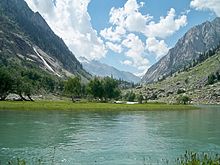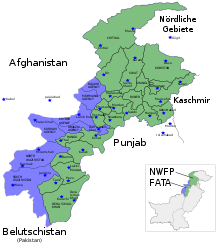Khyber Pakhtunkhwa
![]()
This article or subsequent section is not sufficiently supported by evidence (e.g., anecdotal evidence). Information without sufficient evidence may be removed in the near future. Please help Wikipedia by researching the information and adding good supporting evidence.
![]()
This article or section needs to be revised: The tribal areas under federal administration seem to have been added to the province of Khyber Pakhtunkhwa in the meantime (=2018). This article would need to be updated to reflect this situation.
Please help improve it, and then remove this tag.
Khyber Pakhtunkhwa (Urdu خیبر پختونخوا; Pashtun خیبر پښتونخوا), from 1901 to 2010 North Western Frontier Province (NWFP) is a province of Pakistan. It is predominantly populated by Pashtuns. Large parts of the province once belonged to Afghanistan. The capital of Khyber Pakhtunkhwa is Peshawar. As of May 31, 2018, the former Federally Administered Tribal Areas (FATA) were incorporated into the province of Khyber Pakhtunkhwa. Khyber Pakhtunkhwa is also called Eastern Afghanistan or Pashtunistan by Afghans.
Geography
Khyber Pakhtunkhwa borders (clockwise, starting in the northeast) Gilgit-Baltistan (the former Northern Areas), the semi-autonomous Asad Jammu and Kashmir, Punjab province - with which it encloses the capital territory of Islamabad - Balochistan province, and Afghanistan. With an area of 74,521 km², Khyber Pakhtunkhwa is the smallest province of Pakistan in terms of area. While the plain around the provincial capital Peshawar extends to about 340 m above sea level, the highest peak of the province, the Tirich Mir, is 7708 m high. The western areas on the border with Afghanistan are very dry with sparse vegetation; the central and eastern mountainous areas, on the other hand, already belong to the subtropical continental highlands, with snowy winters, cool summers, and winter and summer rains. In the lowlands around Peshawar, however, the temperature in June/July reaches up to 45 °C.
Khyber Pakhtunkhwa is the most densely forested province in Pakistan. According to the Forest Sector Master Plan of 1993, 17 % of the area is forested (Pakistan: 4.8 %), while 15 % is used for agriculture (Pakistan: 23 %). However, these official figures are doubted by experts, as deforestation is still proceeding rapidly. Several reports have concluded that without drastic measures, the forest in the accessible areas of Khyber Pakhtunkhwa will have disappeared by 2025. Most common species among conifers are Himalayan cedar, teardrop pine, Pinus roxburghii, Pindrow fir, Pinus excelsa and Pinea smithiana. The most common deciduous tree is the walnut.
In the north of the province lies the Chitral Gol National Park, where rare mountain animals such as the screw goat are protected.

Lake Kundol
Administration
Khyber Pakhtunkhwa has existed in its present form since 1901, when it was given the name North West Frontier by the British occupation forces; this was particularly unpopular with the majority Pashtun population.
Administratively, the province is divided into 7 divisions and 34 districts:
Districts
- Abbottabad
- Bajaur
- Bannu
- Batagram
- Buner
- Charsadda
- Chitral
- Dera Ismail Khan
- Hangu
- Haripur
- Karak
- Khyber
- Kohat
- Kolai Palas
- Kurram
- Lakki Marwat
- Lower you
- Lower Kohistan
- Malakand
- Mansehra
- Mardan
- Mohmand
- North Waziristan
- Nowshera
- Orakzai
- Peshawar
- Shangla
- South Waziristan
- Swabi
- Swat
- Tank
- Torghar
- Upper Dir
- Upper Kohistan

Territorial division by 2018: Khyber Pakhtunkhwa (formerly NWFP). Federally Administered Tribal Areas (FATA)
Search within the encyclopedia